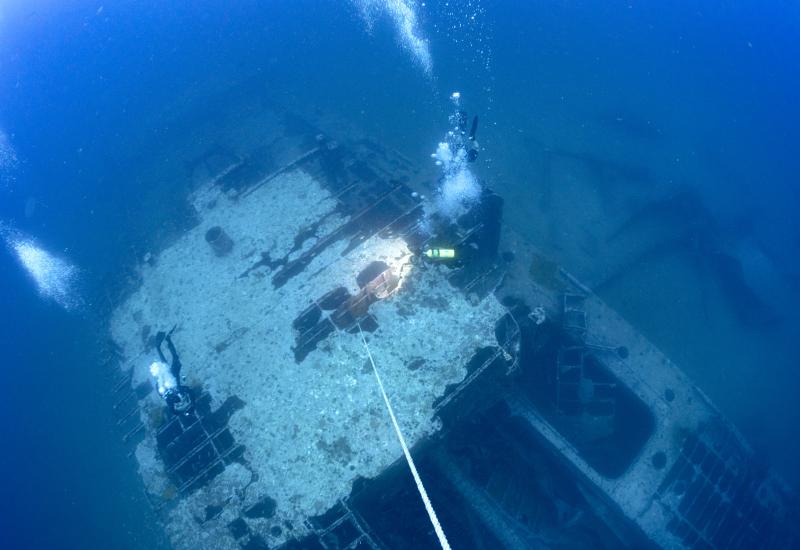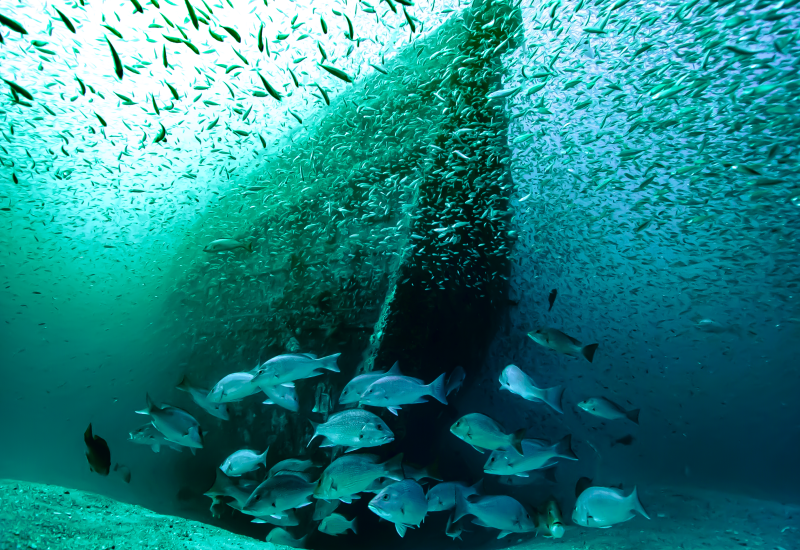Pensacola, Fla.
By Jesse Cancelmo
Directly ahead of me, thousands of minnows slowly drift across a deep blue backdrop, glittering like tiny shards of glass. As I continue down the mooring line and swim through the shroud of shiny life, I’m struck by another image directly below me—an immense gray metal structure coming into view, towering upward from a depth of more than 200 feet. I can see circular and rectangular patterns of handrails near a crow’s nest and make out gratings and a huge stack opening. Farther below I notice a number of distinct levels of the ship with doors, portholes and bay window openings that beckon a look inside. Meanwhile, a school of jacks, indifferent to my appearance, swim in front of me, blocking my view of this massive manmade reef for a second or two. As the 911-foot aircraft carrier USS Oriskany comes clearly into my view, I can only marvel at the sight—she’s the world’s largest artificial reef and uncontested centerpiece of northwest Florida wrecks.
In fact, if there’s such a thing as wreck diver nirvana, Pensacola is it. There’s an impressive catalog here, with more than 100 sunken vessels, military tanks and planes—and even artificial reefs fashioned from demolished intracoastal bridges—bathed in warm, emerald green to sapphire blue waters.
The Mighty O
The Oriskany saw action in both the Korean and Vietnam wars and since its 2006 sinking, "the Mighty O," as she’s affectionately nicknamed, has been sitting in an upright north-south position, 24 miles southeast of Pensacola Pass. The top of her conning tower is at 68 feet, and there’s plenty to explore in her fascinating eight-story-high superstructure. Doors and windows were removed from the bridges to provide divers with better light and safer exits. To get to the flight control bridge, swim aft toward the stack, then descend to about 95 feet to find the window openings facing the flight deck.
The Oriskany has sprouted a healthy and varied marine community, including small scallops that have taken residence throughout the wreck. If you look in the pipe openings and other niches, you’ll see arrow crabs and banded coral shrimp. Queen angelfish and cocoa damselfish openly flutter and flit around the wreck, while gag groupers hide out in the shadows and snappers and amberjacks cruise overhead. If you luck out, you may even spot a loggerhead turtle or a manta ray. There’s so much to see here that it’s best to plan at least two dives to take in the Oriskany’s gargantuan superstructure.
SS San Pablo
This 315-foot former World War II supply and transport vessel rests nine miles south of Pensacola Pass at a depth of 80 feet. In July 1942, while docked at Puerto Limon, Costa Rica, a German submarine sank the SS San Pablo with hits from two torpedoes. In 1943, she was refloated, repaired and towed to Pensacola, and eventually, she was sunk as an artificial reef. Diving the San Pablo reveals her stern and three huge boilers to be intact, but the majority of her hull is twisted steel surrounded by a field of metal debris and rubble. Most of the wreckage resulted from dynamite charges used to reduce the wreck’s height to allow safe navigation for other ships crossing the site. Count on seeing massive schools of snapper and baitfish hovering over the wreck. Hydroids and algae encrust all of the metal surfaces giving the ship a fuzzy, green camouflaged look, and leopard toadfish hide in bottom rubble. Look carefully and you’re bound to spot a spectacular black-and-gold nudibranch known as the Florida regal sea goddess.
Pete Tide II
This oil field supply boat, resting perfectly upright in 105 feet of water, looks like the classic wreck of a Hollywood movie. In 1979, 95 miles southeast of New Orleans, the Pete Tide II’s crew made the mistake of dragging its anchor across a submerged natural gas pipeline, igniting a fire, ravaging the vessel, killing at least one crew member and seriously injuring others. The Pete Tide II was added to Florida’s artificial reef program 15 years ago and has a prominent and easily accessible wheelhouse. That swim-through is a huge attraction for divers—as it is for schools of spadefish. Clumps of hydroids and a scatter of sea cucumbers spot the long stretch of metal decking.
If you have a passion for shipwrecks and artificial reefs like this one, you can’t go wrong in Pensacola, as the variety of vessels in all sizes and configurations has enough appeal to bring even the most well-traveled divers back for more.
InDepth
Getting Around: From the west, take Interstate 110 (Exit 12 off Interstate 10), toward downtown Pensacola. To get to Scuba Shack, at 711 S. Palafox St., take I-10 and exit at I-110 South to the city of Pensacola. Take the Garden Street Exit and go to the third traffic light, and turn left onto Palafox St. The shop is eight blocks on the right side. To get to MBT Divers, at 3920 Barrancas Ave., take I-10 East to Exit 10A and merge onto Pensacola Blvd. Continue and make a slight right on North Pace Blvd., then go right on Barrancas Ave.
Dive Conditions: Surface water temps range from the mid-50s in winter to the mid-70s and mid-80s from May to September. Visibility at inshore sites is generally 25 to 50 feet and from 50 to 100 at the Oriskany. Use minimal thermal protection in summer and a 5 or 7mm wetsuit or drysuit in winter.
Dive Operators: Scuba Shack (scubashackpensacola.com), MBT Divers (mbtdivers.com).
By Jesse Cancelmo
Directly ahead of me, thousands of minnows slowly drift across a deep blue backdrop, glittering like tiny shards of glass. As I continue down the mooring line and swim through the shroud of shiny life, I’m struck by another image directly below me—an immense gray metal structure coming into view, towering upward from a depth of more than 200 feet. I can see circular and rectangular patterns of handrails near a crow’s nest and make out gratings and a huge stack opening. Farther below I notice a number of distinct levels of the ship with doors, portholes and bay window openings that beckon a look inside. Meanwhile, a school of jacks, indifferent to my appearance, swim in front of me, blocking my view of this massive manmade reef for a second or two. As the 911-foot aircraft carrier USS Oriskany comes clearly into my view, I can only marvel at the sight—she’s the world’s largest artificial reef and uncontested centerpiece of northwest Florida wrecks.
In fact, if there’s such a thing as wreck diver nirvana, Pensacola is it. There’s an impressive catalog here, with more than 100 sunken vessels, military tanks and planes—and even artificial reefs fashioned from demolished intracoastal bridges—bathed in warm, emerald green to sapphire blue waters.
The Mighty O
The Oriskany saw action in both the Korean and Vietnam wars and since its 2006 sinking, "the Mighty O," as she’s affectionately nicknamed, has been sitting in an upright north-south position, 24 miles southeast of Pensacola Pass. The top of her conning tower is at 68 feet, and there’s plenty to explore in her fascinating eight-story-high superstructure. Doors and windows were removed from the bridges to provide divers with better light and safer exits. To get to the flight control bridge, swim aft toward the stack, then descend to about 95 feet to find the window openings facing the flight deck.
The Oriskany has sprouted a healthy and varied marine community, including small scallops that have taken residence throughout the wreck. If you look in the pipe openings and other niches, you’ll see arrow crabs and banded coral shrimp. Queen angelfish and cocoa damselfish openly flutter and flit around the wreck, while gag groupers hide out in the shadows and snappers and amberjacks cruise overhead. If you luck out, you may even spot a loggerhead turtle or a manta ray. There’s so much to see here that it’s best to plan at least two dives to take in the Oriskany’s gargantuan superstructure.
SS San Pablo
This 315-foot former World War II supply and transport vessel rests nine miles south of Pensacola Pass at a depth of 80 feet. In July 1942, while docked at Puerto Limon, Costa Rica, a German submarine sank the SS San Pablo with hits from two torpedoes. In 1943, she was refloated, repaired and towed to Pensacola, and eventually, she was sunk as an artificial reef. Diving the San Pablo reveals her stern and three huge boilers to be intact, but the majority of her hull is twisted steel surrounded by a field of metal debris and rubble. Most of the wreckage resulted from dynamite charges used to reduce the wreck’s height to allow safe navigation for other ships crossing the site. Count on seeing massive schools of snapper and baitfish hovering over the wreck. Hydroids and algae encrust all of the metal surfaces giving the ship a fuzzy, green camouflaged look, and leopard toadfish hide in bottom rubble. Look carefully and you’re bound to spot a spectacular black-and-gold nudibranch known as the Florida regal sea goddess.
Pete Tide II
This oil field supply boat, resting perfectly upright in 105 feet of water, looks like the classic wreck of a Hollywood movie. In 1979, 95 miles southeast of New Orleans, the Pete Tide II’s crew made the mistake of dragging its anchor across a submerged natural gas pipeline, igniting a fire, ravaging the vessel, killing at least one crew member and seriously injuring others. The Pete Tide II was added to Florida’s artificial reef program 15 years ago and has a prominent and easily accessible wheelhouse. That swim-through is a huge attraction for divers—as it is for schools of spadefish. Clumps of hydroids and a scatter of sea cucumbers spot the long stretch of metal decking.
If you have a passion for shipwrecks and artificial reefs like this one, you can’t go wrong in Pensacola, as the variety of vessels in all sizes and configurations has enough appeal to bring even the most well-traveled divers back for more.
InDepth
Getting Around: From the west, take Interstate 110 (Exit 12 off Interstate 10), toward downtown Pensacola. To get to Scuba Shack, at 711 S. Palafox St., take I-10 and exit at I-110 South to the city of Pensacola. Take the Garden Street Exit and go to the third traffic light, and turn left onto Palafox St. The shop is eight blocks on the right side. To get to MBT Divers, at 3920 Barrancas Ave., take I-10 East to Exit 10A and merge onto Pensacola Blvd. Continue and make a slight right on North Pace Blvd., then go right on Barrancas Ave.
Dive Conditions: Surface water temps range from the mid-50s in winter to the mid-70s and mid-80s from May to September. Visibility at inshore sites is generally 25 to 50 feet and from 50 to 100 at the Oriskany. Use minimal thermal protection in summer and a 5 or 7mm wetsuit or drysuit in winter.
Dive Operators: Scuba Shack (scubashackpensacola.com), MBT Divers (mbtdivers.com).










